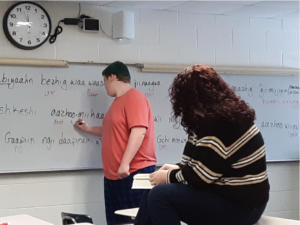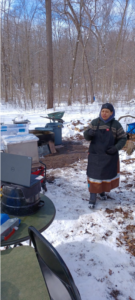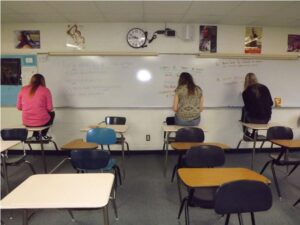 By Haley Jones, MASA Marketing & Digital Media Specialist
By Haley Jones, MASA Marketing & Digital Media Specialist
From zero cultural experiences to a home-grown – and pretty extensive – Native American studies program, Brimley Area Schools has come a long way in 20 years.
When the district started its Diversity, Equity, and Inclusion (DEI) work well over two decades ago, there weren’t any Native Studies courses, or a class to teach Native languages. With a student population of well over 50 percent Native American, something had to be done.
“If we are not meeting the needs of 50 percent of my kids, we aren’t doing something right,” said Superintendent Brian Reattoir.
Today, the district offers Native Studies I and II, Ojibwe Language I and II, and has established numerous cultural experiences and out-of-school activities shining a light on their Native American community.
After a change in the district’s Indian Education Coordinators (now Title VI), the district hired a social studies teacher from the region who had experience in Native American education. Reattoir said the curriculum first started with local history and expanded outward from there. Classes are open to every student, and when it was well received, the district continued to add more courses, including language and higher levels of each class.
“It was more localized at first because we have such a high native population,” he said. “The Sault Tribe has been supportive of what we do, and it takes a good parent committee and an open mind – let’s meet the needs of our kids. That’s the approach.”
The parent committee is how Sonja Killips came into her role as the district’s current Native Studies teacher, a position she has held since 2011.
Killips, a mother of two, had children in the building, and served as a substitute teacher, an assistant to the previous Native Studies teacher Adel Easterday, and a member of the Indian Education Parent Advisory Council for seven years.
 A college student at the time, Killips studied social studies and history at Ferris State University, eventually adding in Native language studies, but learning all the Native Studies curriculum on her own.
A college student at the time, Killips studied social studies and history at Ferris State University, eventually adding in Native language studies, but learning all the Native Studies curriculum on her own.
“I knew I would teach Native Studies, but that isn’t taught in a format that I can go to school and get a major or minor in Native Studies,” Killips said. “I had to learn it all on my own. I had to go the very long way in order to teach my specific material.”
That included building her own personal library that would impress even her elders, she said.
Today the curriculum begins with Native history as early as creation, Killips said, pre-dating Christopher Columbus, and attempts to cover all the important information about the Native American people, while also covering state social studies requirements. While it’s not always easy, it’s fun to do, she said.
“Every day is Native American History Month in classroom 408,” Killips said.
Students also lend a hand in developing curriculum through surveys or their own family history. Killips has had students share their family’s involvement in historical events like the Fishing Wars, or developing Indian education at the state level, and they build the learning opportunities as a community. Killips said she is fortunate to have full curriculum freedom.
Not all students at Brimley Area Schools enroll in the native studies courses offered, but the district creates numerous cultural experiences outside of the classroom to introduce students and community members to Native American Heritage, including a homemade pie sale, presentations from historians and local experts, cooking classes, and one of the district’s largest events – a school powwow.
The student-led event takes place in the gymnasium each year and serves as a social gathering and a way to promote and teach about Native American culture. The event is open to the community and gives Brimley’s native studies students a chance to learn how to plan and execute a large event, and of course, have some fun.
“It’s a social event – it’s fun and relaxing,” Killips said. “They’re having fun and that’s what it should definitely be about.”
 The Michigan Department of Education recently announced that it will partner with education departments from the 12 federally recognized tribes in Michigan to develop curriculum and teacher supports to help students learn about the history of Indigenous Peoples in Michigan.
The Michigan Department of Education recently announced that it will partner with education departments from the 12 federally recognized tribes in Michigan to develop curriculum and teacher supports to help students learn about the history of Indigenous Peoples in Michigan.
“Developing these important learning materials for our educators to share with Michigan children will bring a greater understanding of the history, culture, and contributions of the tribal nations that shared this land with one another,” said State Superintendent Dr. Michael Rice in a press release. “We appreciate the opportunity to deepen our work with our tribal educational partners, whose leadership we value.”
MDE and the 12 federally recognized tribes that share geography with the State of Michigan have been working together for the past six years through CMTED and MDE’s Indigenous Education Initiative to build a cohesive and sustainable approach for collaboration among the tribes, the state, and local entities to identify and address educational issues and shared priorities.
Superintendent Reattoir said having an open dialogue with local tribes is the first step in building a program like the one his district offers.
“Immerse yourself and when they see that you are real, and want to work together to offer opportunities to all kids, then things really fly,” he said.
Killips echoed Reattoir’s advice and said districts should look within their own communities for future Native Studies teachers. Find your key personnel and help them, even if they aren’t qualified.
“We don’t jump up and down and say, ‘here we are,’” she said. “Who has that bright star in their eye that can take on the teaching, grant work, and paperwork for all of it?”
Beyond the curriculum and cultural events, the Native Studies program at Brimley Area Schools is also adding to an increase in student achievement and involvement. Students will excel more if their needs are met, Reattoir said – educationally, social emotionally, and culturally.
“If they don’t feel they are included, they won’t feel safe, or invited or wanted in the programming,” he said. “That is the best way that student outcomes happen is when they feel included and have a voice.”
